The Museo Tamayo presents the first monographic exhibition of Cerith Wyn Evans’ work in Mexico. The exhibition gathers twelve pieces produced in the last ten years, which seeks to trigger sensitive and temporary experiences in the viewer, as well as to challenge the ideas of perception, cognition, subjectivity, and reality.
In his work, Wyn Evans creates moments of rupture within existing structures of communication –whether visual, audible or conceptual – using the ‘strategies of refraction, of juxtaposition, superimposition and contradiction, occluding and revealing’. Seeing the exhibition as an ‘experiment’ with fluid recourse to scores, maps, instructions and diagrams, he aims to question our notion of reality and cognition, perception and subjectivity, evoking new and unforeseen registers of perception.
For this exhibition at Museo Tamayo, Cerith Wyn Evans addresses the material and the immaterial through the transformative effects of light, sound and the phenomenological experience of space. Responding specifically to the architecture of the museum, the works act as catalysts, observing sight lines, creating ‘sound-lines’ traversing exhibition spaces, as if in dialogue or ‘in concert’ with each other. They create a transversal passage through different temporal episodes, evoking dimensions exploring intangible themes through a range of different media.
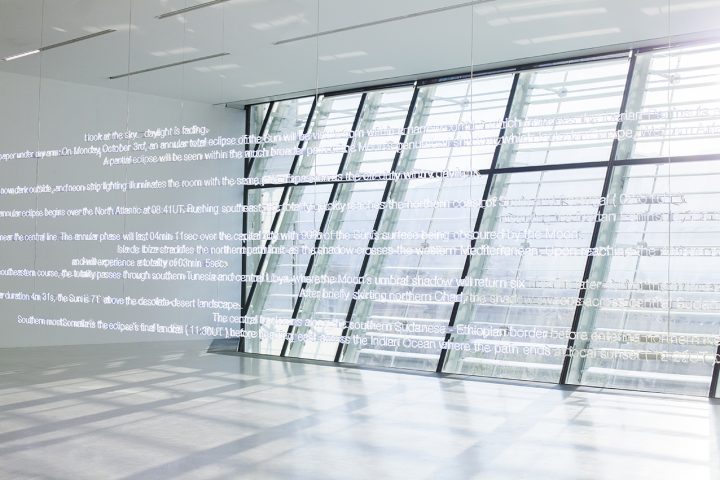
The show centres around the large-scale work E=C=L=I=P=S=E (2015), installed in the central patio/atrium space. In this work, suspended from the ceiling, a neon text describes the temporal and geographic progression of an eclipse of the sun across several continents. Another neon text work: Aquí el espacio se transforma en tiempo…aquí el tiempo se transforma en espacio… (Time here becomes space…space here becomes time…), encapsulates Wyn Evan’s key themes of perception and duration. Syncopating notions of location, perception and communication – through textural reference—in one poetic gesture, they echo Wyn Evans comment that his exhibitions “…examine the transformative Site/Sight/Cite effects that light, sound and duration can have on both spaces and their occupants”
In two new works, Sutra (Patio Central) and Mantra (Sala II) (both 2017), pairs of ornate glass chandeliers (fabricated to the artist’s specifications by Galliano Ferro in Murano) flash on and off, their duet illumination driven by a piano score composed and performed by the artist. Closely relating to the artist’s previous series of chandelier/light works which are driven by Morse code (a translation of excerpts of texts, fed through a software system), these works explore the potential of audio, transformed and transfigured into light.
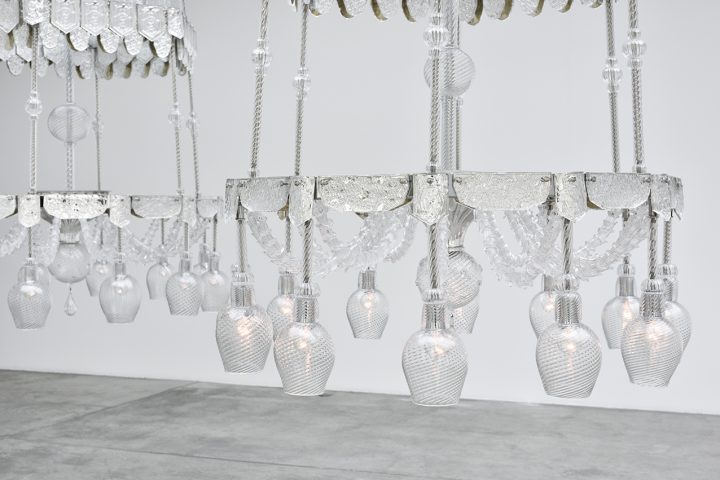
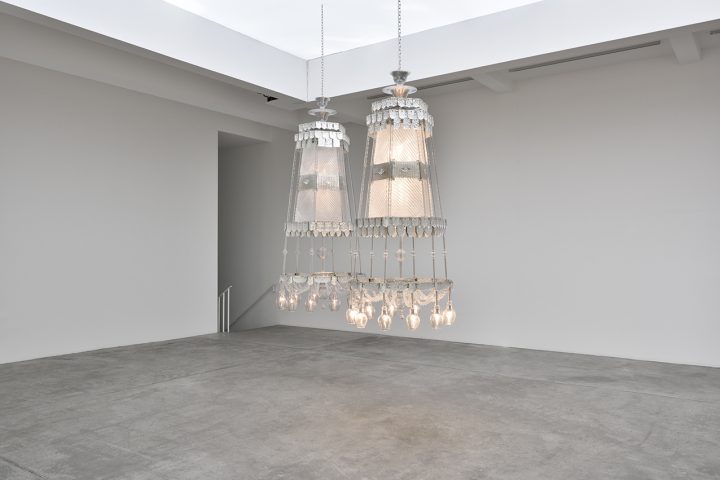
In Composition for 19 Flutes, 2015, a group of glass flutes are suspended at different heights from the ceiling in a radial, fan-like arrangement. They emit a mellifluous sound, derived from air blown into them via a series of transparent tubes, which is modulated to create intervals at different volumes, timbres, pitches and densities. The work produces an expansive microtonal resonance which reverberates throughout the exhibition.
In Still life (in course of arrangement…) II, 2015, situated in the same space, trees are placed on turntables which rotate almost imperceptibly. Bathed in the glow of overlapping spotlights redolent of converging elliptical penumbra, a shadow play performs across a wall. The work suggests an ‘otherworldly’ presence. On the walls, S=H=A=D=E (Evacuate), 2017, presents the 22 pages of Stéphane Mallarmé’s poem Un Coup de Dés Jamais N’Abolira Le Hasard (1897), individually framed and with all the words cut out evoking Marcel Broodthaers’ erasure of the text here, further, ‘liberated’ into space. The rhythmic lines of the poem appearing like some kind of code or musical score replaced by rectangular apertures, the work creates new visual analogies and meaning through the process of concealment, erasure and evacuation.
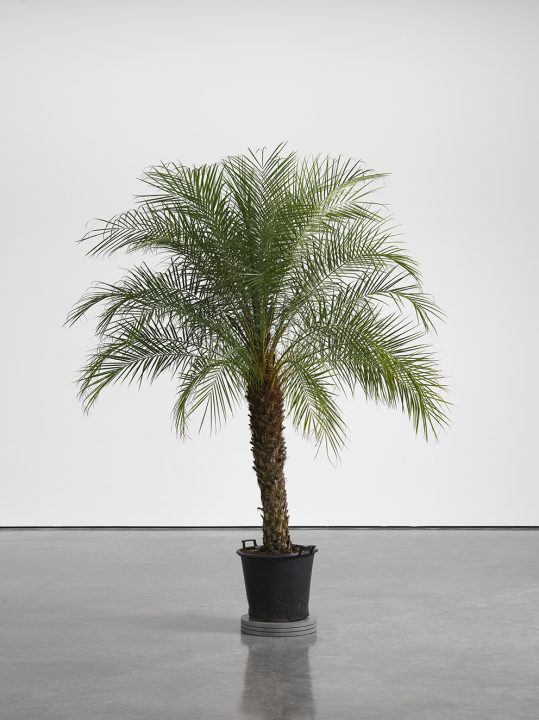
The Illuminating Gas…(after Oculist Witnesses), 2015, draws inspiration from the mysterious tripartite radial forms of the ‘Oculist Witnesses’ in Marcel Duchamp’s iconic work The Bride Stripped Bare by Her Bachelors, Even (1915-23). Three vast discs in bright white neon recreate the forms of Duchamp’s original into three-dimensional and multi-dimensional objects. Suspended from the ceiling at a skewed angle, the work imposes a foreshortened perspective, evoking unfamiliar registers of perception and creating a rupture in the visual field.
Neon Forms (After Noh II) and Neon Forms (After Noh III), both 2015, consist of complex ‘scores’ made articulate in white neon. Suspended from the ceiling by cables, arcs extend, fold and disappear into space through a combination of delicate single lines and dense chaotic clusters. Through multiple layers and points of entry they resist closed form creating suspended ‘figures’ that appear from some angles as if drawn from a single broken line while from others, as if extruding and collaging space itself and making our experience of them elastic. These converging forms and intersecting curves suggest energetic nuclei barely contained. The complex forms or figures suggest the folds and flows of energy via material and immaterial conduits, circuitry and choreology—the practice of translating movement into notational form. Incorporating some of the codified and precise movements of Japanese Noh theatre adopted in previous neon works, as well as elements from earlier sculptures that transposed diagrammatic flight paths into neon. They trace a trajectory of alignments, gestures, folds, orientations and footsteps; transposing spacio/temporal energy into material charge and illuminating forms.
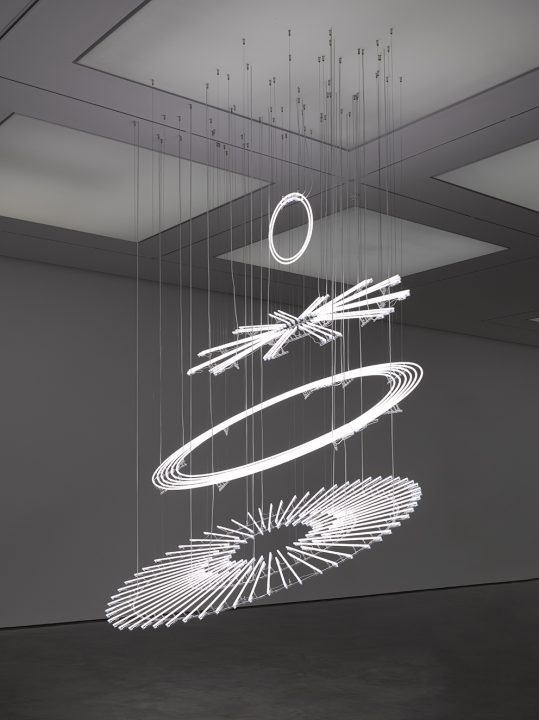
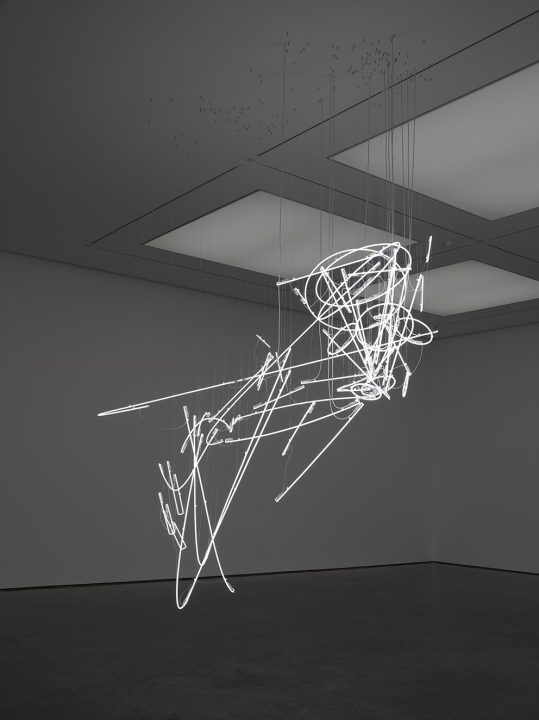
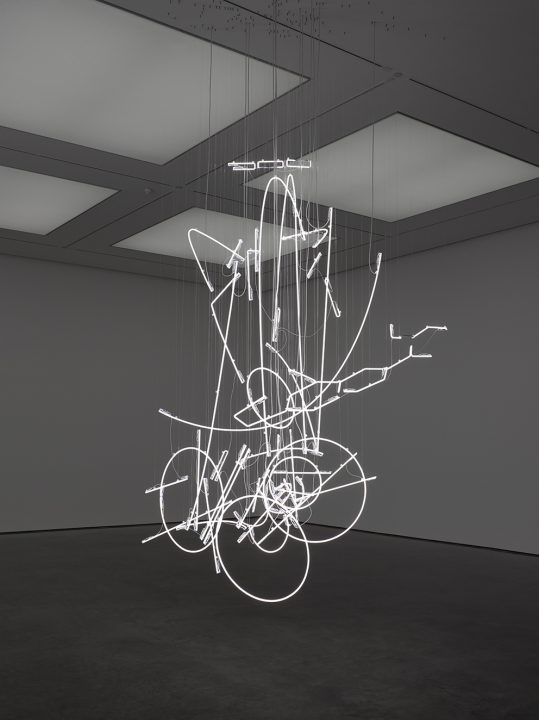
Finally T=R=A=N=S=F=E=R=E=N=C=E (Frequency shifting paradigms in streaming audio), 2012, is placed on the floor. This singularly directional speaker creates an ‘audio column’ emitting excerpts from live streaming recordings taken from radio telescopes. The column promotes a physical beam of sound which transmits observations and analysis of radiated signals from planets, stars and other astrophysical objects.
Cerith Wyn Evans (llanelli, United Kingdom, 1958) started his career as filmmaker by producing movies and collaborating in the projects of different authors. Since the 90’s, he has mainly produced pieces focused on language and perception, most of the times through specific location projects. He has had solo exhibitions at the Tate Britain (London), Haus Konstruktiv (Zurich), Museion Bolzano (Italy) and TBA-21 Augarten (Vienna), as well as in the Skulptur Projekte Münster (Germany), the 57the Venice Bienniale, among other spaces.

 Español
Español